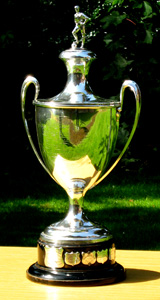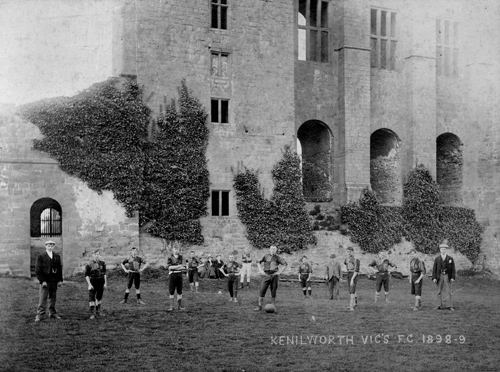The Kenilworth Convalescent Home Football Challenge Cup
(First published, August 17th 2007)

In the early 20th century, Kenilworth had two notable football teams, The Town and St Johns Rovers. Occasionally, they played each other in charity matches, 300 spectators raised funds for Warneford Hospital at one such match in 1907. They also took part in local charity competitions including the Leamington Hospital Cup, the Foleshill Nursing Cup and the Warwick Charity Cup.
Living on Park Hill was Captain James Stringer, a man noted for giving to good causes – in 1898 for example, his donation of £50 started the fund for Kenilworth to have a steam fire-engine. In 1907, Stringer donated a new football trophy, the “Kenilworth Convalescent Home Football Challenge Cup”, to be played for by teams within a 12-mile radius. The Convalescent Home, opened in 1878, survived entirely upon donations; some of these were large bequests, others amounted to just a few shillings, proceeds from the football competition would be a welcome boost.
The 22 inch high trophy, unveiled at the Kenilworth Town AGM at The Globe Hotel in August 1907, was made by James Deakin and Son in Sheffield and the hallmarks confirm it was a new trophy. Twenty-three teams entered the first competition and, as representatives of all the clubs involved were to be present, a convenient location needed to be found to make the draw. With railways being the popular mode of transport, it is not surprising that the Coffee Tavern near Kenilworth Station was chosen; today it is the popular Priory Road fish and chip shop.
It was unfortunate for Kenilworth Town that they were drawn away to Leamington Town, the strongest team in the competition, and Leamington ran out 4-0 winners in a match played in front of 500 spectators at their Tachbrook Road ground, later known as The Windmill. St Johns had a bye in the first round, but in the next were also beaten by Leamington Town. To no-ones surprise, Leamington reached the final and beat Longford 4-0. The match was played, as were all the known finals, at Kenilworth’s Station Fields ground, roughly on the site of today’s junction of Farmer Ward and Blackthorn Roads. It was postponed from its original date, April 25th 1908, due to a snow-storm, and when played on September 19th provided a memorable spectacle; “There was a deal of unpleasant feeling which later led to rough play. One of the Longford players was disabled early in the game, and it looked at one time as if there would be a free fight.” “The many palpable fouls, dangerous heavy charges, and other tricks (including several bouts of fisticuffs) disgusted the majority of spectators.” The Convalescent Home benefited by 5 guineas.
Leamington Town won the trophy again the following year and then dropped out of the competition. It was not to be until the 1909-10 season that Kenilworth Town finally got its name on the trophy by beating Stoke Albion of Coventry 2-0 in the final with Snell and Roberts scoring the goals. The Kenilworth Brass Band played on the pitch during the event, and escorted the victorious Kenilworth team back to the Globe Hotel to the strains of “See the Conquering Hero Comes”. Kenilworth Town retained the trophy the following season, again beating Stoke Albion, this time 3-2.
The cup returned to Kenilworth in 1923 with a 2-0 victory by Town over the holders Cow Lane EMC, with Walford scoring both goals in front of a record crowd of over 1,000. The last victory recorded on the trophy plinth was by Courtaulds Thursday Club in 1934.
At the instigation of Harry Sunley, the trophy re-surfaced some 50 years later and it was suggested as the prize for a proposed annual match between teams from Kenilworth and its “twin” Bourg Le Reine. In 1987, Kenilworth Rangers travelled to France and took on a team consisting largely of fire-fighters; the French team won, and were duly presented with “The Friendship Cup” – a poor impostor compared to the original although a winners plate has been added to the plinth. As far as is known, a return match in Kenilworth has not been played, the Friendship Cup remains in Bourg fire-station, and the Convalescent Cup never left Kenilworth.
Today the trophy, 100 years old this month, is kept safely locked away in its padded box, but brought out, polished and displayed on special occasions.
I would be delighted to hear from anybody who has any information, perhaps gleaned from relatives, about pre-war football and other sports in Kenilworth.
Note: The full story of the ‘Convalescent Cup’ is told in ‘Kenilworth People and Places, Volume 1’, including photographs of winning teams and details of every season of the competition.
Kenilworth Victorias, 1898
(First published September 14th, 2007)

Following the publication of my article about the Kenilworth Convalescent Home Football Challenge Cup (KWN August 17th), Arthur Astrop has given me the accompanying splendid photograph of the Kenilworth Victorias football team of 1898-99 season, posed in front of the castle. This is probably the oldest known photograph of a Kenilworth sporting club*.
The photographer, W F Kimberley of Castle Grove, was on the committee of the club and an occasional player. The team has lined up in formation with the goalkeeper at the back, two full-backs in front, three half-backs, and five forwards nearest the camera. A typical line-up for the team early in the season was A. Sewell; F Holmes, G White; H Roberts, A Colledge, W Lewis; Fred Holmes, C Collett, E Barber, H Holmes, H Bennett. The Holmes family were prominent and it is thought that the bowler-hatted gentleman may be William Holmes, coachbuilder of Station Road, on whose field at Crackley Lane the team played.
The club is first reported prominently in the 1897-98 season, but in the 1898-99 season they are the only Kenilworth club that had any match reports published, they seem to have become the town’s foremost team. However, they are not mentioned again and many of the players can be found playing for other Kenilworth teams; it seems the Victorias disbanded.
*This has now been superseded by another photograph of the same club c1896, published in Kenilworth People & Places Volume 3